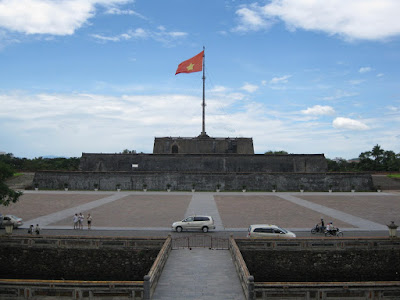The entrance to the Imperial Enclosure:
 Looking out from the roof of the entrance gate:
Looking out from the roof of the entrance gate: Inside:
Inside:
















 Exploring Hue:
Exploring Hue:

 While checking out these old American weapons captured in the war I met a moto-taxi driver named Thinh (pronounced tin.) He just happened to be there, hanging around with his moterbike. Assuming that I didn't know much about the war he explained that they were American weapons and that the war lasted untill 1975. Turned out he had quite a story. His home was destroyed and his father was killed by American soldiers in 1972 when he was 11 years old. He was living in a public market with his mother where Buddhist monks would come by offering people prayers and whatever help they could. His mother, unable to provide for him, asked the monks to take care of him. He ended up living at a pogoda and studying Buddhism for the next eleven years. When he asked me where I was from and I said America he, to my surprise, seemed pleasantly surprised. He told me that his teacher at the pagoda was now living in California and had once met with Martin Luther King jr, who later nominated him for a Nobel Peace Prize. It all sounded hard to believe, but I didn't feel like I was being lied to. He seemed very sincere. He offered to come pick me up the following morning and, for a small price, show me around the area. . . . I accepted and it was awesome.
While checking out these old American weapons captured in the war I met a moto-taxi driver named Thinh (pronounced tin.) He just happened to be there, hanging around with his moterbike. Assuming that I didn't know much about the war he explained that they were American weapons and that the war lasted untill 1975. Turned out he had quite a story. His home was destroyed and his father was killed by American soldiers in 1972 when he was 11 years old. He was living in a public market with his mother where Buddhist monks would come by offering people prayers and whatever help they could. His mother, unable to provide for him, asked the monks to take care of him. He ended up living at a pogoda and studying Buddhism for the next eleven years. When he asked me where I was from and I said America he, to my surprise, seemed pleasantly surprised. He told me that his teacher at the pagoda was now living in California and had once met with Martin Luther King jr, who later nominated him for a Nobel Peace Prize. It all sounded hard to believe, but I didn't feel like I was being lied to. He seemed very sincere. He offered to come pick me up the following morning and, for a small price, show me around the area. . . . I accepted and it was awesome.  I love this sign. . . .
I love this sign. . . .
 Propaganda at the war "museum"
Propaganda at the war "museum"































No comments:
Post a Comment